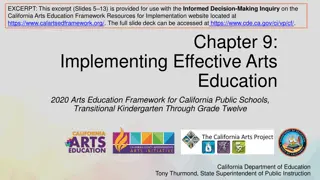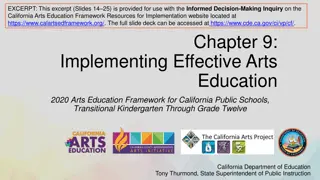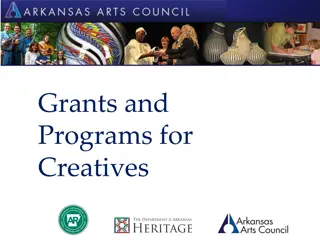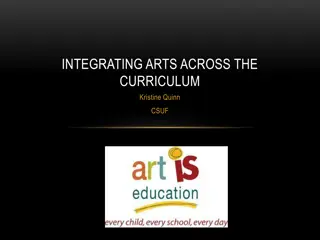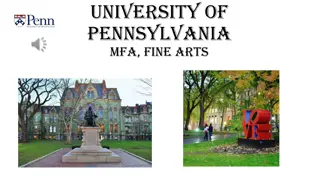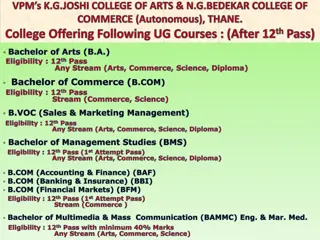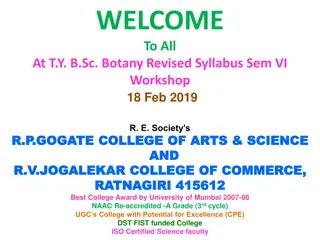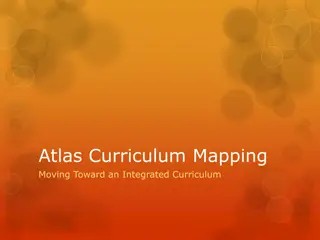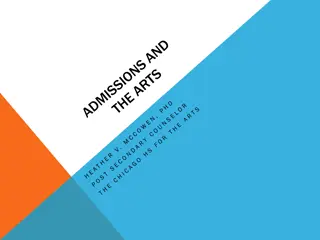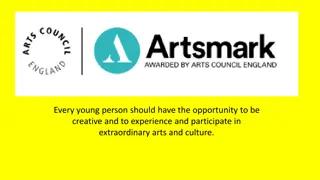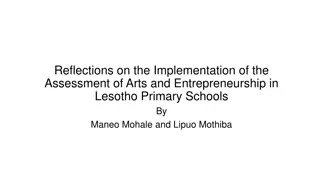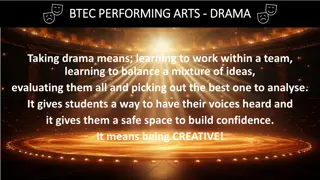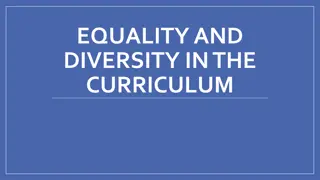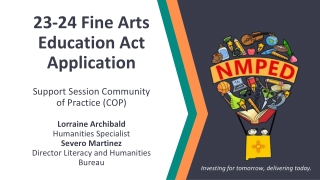Diversity Self-Study in the Curriculum of a Small Fine Arts College
San Francisco Art Institute conducted a diversity self-study in 2015-16 to address concerns about diversity and inclusivity in the curriculum. The study aimed to align with the college's Diversity Statement and Institutional Learning Outcomes, utilize assessment tools, and promote diversity, equity, and inclusion in higher education.
Download Presentation

Please find below an Image/Link to download the presentation.
The content on the website is provided AS IS for your information and personal use only. It may not be sold, licensed, or shared on other websites without obtaining consent from the author. Download presentation by click this link. If you encounter any issues during the download, it is possible that the publisher has removed the file from their server.
E N D
Presentation Transcript
Diversity Self-Study in the Curriculum (of a small, fine-arts college) San Francisco Art Institute Jose de los Reyes, Director of Institutional Research & Registrar
Context: Conducted in 2015-16 by the Program Assessment Committee of the Faculty Senate to be that year's Self-Study as requested by the President Committee composed of 3 full-time faculty and 3 staff In Fall 2015, students were voicing concerns about diversity and inclusivity on campus, including the curriculum Self-Studies are typically done for degree programs at SFAI Study limited to the curriculum 2
Committee Goals: 1. Align the study with the Diversity Statement and the Institutional Learning Outcomes of the college. 2. Find pre-existing assessment tools related to these alignments. 3. Find pre-existing data related to these alignments for analysis. 4. Deploy other assessment tools that can help the self-study. 5. Based on assessments, use the Self-Assessment Rubric for the Institutionalization of Diversity, Equity, and Inclusion in Higher Education by the New England Resource Center for Higher Education (NERCHE) Multicultural Affairs Thinktank. 3
Goal 1: Alignment of study with stated outcomes A. SFAI s Diversity Statement (adopted October 2012) A rigorous artistic and intellectual community is enriched by diversity and inclusion. We promote artistic and intellectual freedom by fostering environments that value our diverse students, faculty, and staff and provide all community members with a respectful and challenging space in which to address divergent opinions and ideas. By "diversity", we mean that our community prospectively embraces differences in gender expression and identity, age, culture, ethnicity, race, sexual orientation, physical ability, learning style, religion, occupation, nationality, immigration status, socio-economic status, and the many forms of composite subjectivity and life experience that span these differences. Promoting such a broadly inclusive understanding of diversity requires ongoing education and effort, to ensure support, understanding, and awareness from all community members. In this, SFAI strives to move beyond the reactive methodologies of affirmative action, even as we proactively practice equal opportunity in hiring and admissions. SFAI seeks to be a vanguard institution with regard to how we address and integrate notions of diversity. The Institute continues to develop connections and mutually beneficial relationships between the school's immediate community and local and global publics in the belief that a multiplicity of voices has helped to make SFAI the influential and inspiring institution that it is today. 4
B. SFAIs Institutional Learning Outcomes (adopted January 2015) The San Francisco Art Institute's vision includes a commitment to promoting global perspectives, social responsibility, environmental sustainability, and critical understandings of art for different audiences. This is demonstrated through our dedication to: 1. Advancing art and its critique as a significant form of knowledge making 2. Recognizing the consequential roles that artists play in society 3. Employing multiple techniques in pursuit of creative solutions 4. Negotiating disciplinary boundaries 5. Expanding sites of artistic engagement at local and global levels 6. Representing the complexity of social and cultural difference The committee decided that items 2 to 6 had potential to address notions of diversity as learning outcomes. 5
Goal 2: Pre-existing assessment tools related to alignments A. Course Evaluations Find diversity-related questions; of 78 discrete questions, 10 were found to be aligned to stated diversity outcomes. Normalize scoring scale to 0 to 100 due to variance in scales. 6
Average scores of diversity-related questions, ranked highest to lowest. 1 - Has your attentiveness to artistic examples across new and old cultures been encouraged? (PA; N=128) 97 2 - Have you expanded your understanding of the history of ideas and values in an interdisciplinary and cross-cultural context? (LA, PB; N=208) 94 3 - Is the critique environment conducive to constructive learning for students of all genders and sexual identities? (GCS; N=130) 91 4 - Is the critique environment conducive to constructive learning for students of all cultures and ethnicities? (GCS; N=132) 90 5a - Is the critique environment conducive to constructive learning for students working within various theoretical frameworks, including critical race theory, feminism, post- colonialism, and/or other? (GCS; N=129) 89 5b - Do you feel better able to contextualize art practice within larger social and cultural frameworks, including the histories of modernity, modernism, cosmopolitanism and globalism? (HTCA; N=175) 89 5c - Do you feel that the classroom environment encourages equally participation by, and recognition of, all students? (GCS; N=134) 89 8 - If this course was a seminar, the instructor made an effort to encourage all students to engage in discussions or critiques (All; N=1538) 87 9 - Have you refined your understanding of the relation between the art you make and the art of your contemporaries--are you better able to consider this collective work as part of a larger dialogue about the place of art-making in the world? (GCS; N=133) 86 Mean of Average Scores 10 - Do you feel better able to articulate how exhibitions and museums, and the work contained therein fit within a larger social, critical, cultural, and historical context? (EMS; N=10) 77 0 10 20 30 40 50 60 70 80 90 100 The subject codes as available and their descriptions: PA (Painting), LA (Liberal Arts), PB (Post-Baccalaureate), GCS (Graduate Critique Seminar, HTCA (History and Theory of Contemporary Art, All (global distribution), EMS (Exhibition & Museum Studies). 7
B. BFA Learning Outcomes Rubric Since Spring of 2011, SFAI has been assessing the body of work of each senior using an outcomes rubric composed of 8 categories. The current version, used since Spring 2014, uses the following categories: 1. Technical. Demonstrates technical facility in the development and implementation of the work 2. Conceptual. Demonstrates conceptual facility in the development and implementation of the work. 3. Historical. Demonstrates a historical context. 4. Theoretical. Demonstrates a theoretical context. 5. Research. Demonstrates a thorough understanding of a discipline (major) and situates artistic and scholarly work within the broader field of cultural and historical discourses. 6. Interdisciplinary Engagement. Demonstrates a relationship to additional media and disciplines. For each category, the body of work is scored from 1 (Emerging) to 5 (Mature). 8
Average score in BFA Rubric categories, highest to lowest. Rank Category Average Score (1 to 5) (std dev) 1 SR Technical 4.39 0.79 2 SR Interdisciplinary 4.24 0.89 3 SR Conceptual 4.19 0.97 4 SR Research 4.11 0.94 5 SR Historical 3.97 0.95 6 SR Theoretical 3.81 1.00 9
Average score in BFA Rubric categories per term. 4.70 SR Technical ( =0.14) 4.50 SR Conceptual ( =0.15) 4.30 SR Historical ( =0.17) 4.10 SR Theoretical ( =0.08) 3.90 SR Research ( =0.07) 3.70 SR Interdisciplinary ( =0.19) 3.50 SP2014 (n=55) FA2014 (n=13) SP2015 (n=49) FA2015 (n=35) 10
C. Global Cultures Requirement Studies in Global Cultures is a 3-credit requirement for degree-seeking undergraduates. Studies in Global Cultures Developing an understanding of diverse cultures, knowledges, and ways of being is crucial for contemporary artistic development and meaningful civic participation, especially considering profound transformations occurring through processes of globalization. The Studies in Global Cultures requirement ensures that students learn about human experiences beyond a dominant Western perspective, and includes courses that focus on diverse cultures, ethnicities, and religions, as well as gender and sexual orientation. Importantly, this liberal arts requirement may be fulfilled through a wide range of courses in the studio fields, as well as in art history, the social sciences, and humanities. 11
Classes satisfying the Global Cultures requirement, Summer & Fall 2015. Term FA2015 FA2015 FA2015 FA2015 FA2015 SU2015 FA2015 FA2015 FA2015 FA2015 Total Code AT-211-01 HTCA-220I-01 HUMN-214-01 HUMN-217-01 HUMN-219-01 HUMN-221-01 MATH-116-01 PH-320-01 SOCS/US-122-01 US-296-01 (10 classes) Title Rethinking the "Artist" Between Dreams and Reality Protest Politics Human Rights Women and Islam Other Ways of Reading Making Space Sacred and Profane I Manufacturing Paradise City Studio Practicum Students 12 19 19 15 9 16 20 8 19 11 148 12
Diversity-related course evaluation questions, Global Cultures vs all classes. Scores normalized to a 0-100 scale. Score - Global Cultures Diversity-related Course Evaluation Question/ (Subject Distribution/Scale) Score - All If this course was a seminar, the instructor made an effort to encourage all students to engage in discussions or critiques (Global/1 to 5) 87 87 (N=83) (N=1538) Do you feel better able to contextualize art practice within larger social and cultural frameworks, including the histories of modernity, modernism, cosmopolitanism and globalism? (HTCA/Freeform) Have you expanded your understanding of the history of ideas and values in an interdisciplinary and cross-cultural context? (Lib Arts/Freeform) 89 89 (N=6) (N=175) 98 94 (N=40) (N=213) 13
Goal 3: Analyze pre-existing data with alignments A. Syllabi Course syllabi has data that can evidence diversity or inclusivity outcomes: authors, artists, media, topics, learning outcomes, etc. Faculty members of the committee developed a Diversity Rubric to assess diversity outcomes based on syllabi data. Syllabi from Academic Years 2013 and 2014 were graded; a total of 504 syllabi. Syllabi were distributed to faculty based on specializations; we found significant variance in scoring rigor among evaluators. 14
Diversity Rubric for Syllabi Course Name: Course Number: Semester: Indicators/ Comments Components Stage One: Emerging Stage Two: Developing Stage Three: Transforming Non-Apparent KNOWLEDGE AND AWARENESS OF DIVERSITY, INCLUSION, AND EQUITY IN RELATION TO DISCIPLINES (course description and orientation) Few aspects of the course recognize how multiple ways of knowing impact teaching and learning in the classroom. Many aspects of the course recognize multiple ways of knowing and incorporate multiple ways of knowing into teaching and learning practice. Most aspects of the course incorporate multiple ways of knowing into teaching and learning practices The value of diversity, inclusion and equities evidenced in the course materials in certain areas and not in others. A commitment to diversity, inclusion and equity has an informing influence, albeit inconsistently. The instructor has integrated a limited, but purposeful, variety of inclusive teaching and learning approaches that is designed to respond to the diverse experiences of students in their classes. The syllabus reveals some resources to support the development of inclusive teaching and learning approaches that are designed to respond to the diverse experiences of all students in any given classroom. Evidence of a strong value for diversity, inclusion and equity is easily apparent throughout the course materials. A commitment to diversity, inclusion and equity clearly has an informing influence. COURSE MATERIALS (Study materials, visual archives, etc.) Coursework as it is currently constituted is only minimally related to diversity and inclusiveness. The instructor has clearly integrated a variety of inclusive teaching and learning approaches that are designed to respond to the diverse experiences of students in their classes. The instructor has integrated few teaching and learning approaches designed to respond to the diverse experiences of students in their classes. FACULTY TEACHING AND LEARNING STRATEGIES AND METHODS The syllabus reveals few if any resources to support the development of inclusive teaching and learning approaches that are designed to respond to the diverse experiences of all students in any given classroom. The syllabus clearly reveals many resources to support the development of inclusive teaching and learning approaches that are designed to respond to the diverse experiences of all students in any given classroom. TEACHING AND LEARNING RESOURCES (Teaching and learning centers, mentoring programs, etc.) Few student learning outcomes identify the need for diversity, inclusion and equity as part of their typical assessment practices. Some student learning outcomes focusing on diversity, inclusion and equity as part of their typical assessment practices. Most student learning outcomes focus on diversity, inclusion and equity as part of their typical assessment practices. STUDENT LEARNING OUTCOMES Few course research and performance requirements reflect a commitment to diversity, inclusion and equity as an integral asset to disciplinary and institutional integrity in form and content. Many course research and performance requirements reflect a commitment to diversity, inclusion and equity as an integral asset to disciplinary and institutional integrity in form and content. Most course research and performance requirements reflect a commitment to diversity, inclusion and equity as an integral asset to disciplinary and institutional integrity in form and content. RESEARCH and PERFOMANCE PROJECTS Add up the number of points in this column. Each designation in this column is worth 1. Add up the number of points in this column. Each designation in this column is worth 2. Add up the number of points in this column. Each designation in this column is worth 3. TOTAL NUMBER OF DESIGNATIONS IN EACH COLUMN (Number of descriptions circled above) _________ _________ _________ Total Score: _____ /18 transforming = 14-18 developing = 11-13 emerging = 8-10 fails to adequately satisfy = 0-7 STANDARDS-BASED SCORE Overall Assessment: 15 see right for scoring range
Syllabi Diversity Rubric scores by evaluator. Average Syllabus score 13.2 Average Syllabus t-score Evaluator Areas Syllabi 1 2 3 4 5 BA, MA (all subjects) BFA (AT, FM, PA, SC) BFA (NG, PH, PR) BFA (CP, IN), MFA (all subjects) MFA (all subjects) 173 139 88 92 12 9.0 9.0 9.0 9.0 9.0 7.2 12.3 9.5 6.1 Scores were normalized using z-scores; where z = (x - )/ and , are based on the population. Z-scores where then transformed to t-scores; where t = + ( )(z) and , are adjusted variables. In this case, was set to 1.5 and was calibrated so that the highest t-score per component is 3. 16
Syllabi Diversity Rubric scores by department. The scoring scale is 0-18. 8.94 BA (N=130) 13.06 9.05 BFA (N=251) 9.29 Average of t-score total Average of total 9.18 MA (N=43) 13.53 8.83 MFA (N=80) 8.60 0.00 5.00 10.00 15.00 17
Syllabi Diversity Rubric t-scores by BFA subjects. The scoring scale is 0-18. 10.61 Contemporary Practice (N=10) Art & Technology (N=17) 9.95 Film (N=34) 9.43 Printmaking (N=27) 9.11 New Genres (N=22) Average t-score 9.04 Photography (N=37) 8.95 Sculpture/ Ceramic Sculpture (N=31) 8.74 Interdisciplinary (N=16) 8.73 Painting/ Drawing (N=57) 8.60 1.00 3.00 5.00 7.00 9.00 11.00 13.00 18
Syllabi Diversity Rubric Component t-scores by BFA subjects. The scoring scale is 0-3, from Non- Apparent to Transforming. 1.75 KNOWLEDGE AND AWARENESS OF DIVERSITY, INCLUSION, AND EQUITY IN RELATION TO DISCIPLINES (course description and orientation) 1.90 1.62 1.36 1.56 Art & Technology (N=17) Contemporary Practice (N=10) Film (N=34) 1.40 1.46 1.51 1.41 1.63 1.97 1.58 COURSE MATERIALS (Study materials, visual archives, etc.) 1.55 1.42 1.40 1.56 1.51 1.53 1.67 1.77 Interdisciplinary (N=16) 1.55 FACULTY TEACHING AND LEARNING STRATEGIES AND METHODS 1.43 1.51 1.46 1.39 New Genres (N=22) 1.65 1.43 1.69 1.74 TEACHING AND LEARNING RESOURCES (Teaching and learning centers, mentoring programs, etc.) 1.59 Painting/ Drawing (N=57) Photography (N=37) 1.51 1.48 1.42 1.57 1.42 1.45 1.58 1.61 1.56 1.40 Printmaking (N=27) STUDENT LEARNING OUTCOMES 1.58 1.48 1.44 1.51 1.42 1.63 Sculpture/ Ceramic Sculpture (N=31) 1.61 1.53 1.48 RESEARCH and PERFORMANCE PROJECTS 1.48 1.45 1.52 1.51 1.49 0.75 1.00 1.25 1.50 1.75 2.00 2.25 19
Syllabi Diversity Rubric component average scores (N=504). KNOWLEDGE AND AWARENESS OF DIVERSITY, INCLUSION, AND EQUITY IN RELATION TO DISCIPLINES (course description and orientation) 1.95 COURSE MATERIALS (Study materials, visual archives, etc.) 1.53 FACULTY TEACHING AND LEARNING STRATEGIES AND METHODS 1.85 TEACHING AND LEARNING RESOURCES (Teaching and learning centers, mentoring programs, etc.) 1.78 STUDENT LEARNING OUTCOMES 1.70 RESEARCH and PERFORMANCE PROJECTS 1.71 0.00 0.50 1.00 1.50 2.00 2.50 3.00 20
B. Faculty Specializations: Wordcloud of faculty majors. 21
C. Faculty Development Grants (2013-2015) Grant Year 2013-14 2013-14 2013-14 2013-14 2013-14 2013-14 2013-14 2013-14 2013-14 2014-15 2014-15 2014-15 2014-15 2014-15 2014-15 2015-16 2015-16 2015-16 2015-16 2015-16 2015-16 2015-16 2015-16 2015-16 2015-16 2015-16 2015-16 2015-16 2015-16 2015-16 2015-16 2015-16 Cycle Fall Fall Fall Fall Winter Winter Winter Winter Winter Fall Fall Fall Fall Winter Winter Fall Fall Fall Fall Fall Fall Fall Fall Fall Fall Winter Winter Winter Winter Winter Winter Winter Request Name City of Oakland book Photo Expert Assistant fees Great Lakes Exhibition Media City Biennial + China Rudi Gernreich publications Felix Culpa print/paint project China Re-Seen Gallery Paule Anglim Exhibition Dream Vortex Ljubljana Biennial of Graphic Arts - Tree Talk series ReVisioning China Hamilton Wood Type Residency Dream Vortex - final stage Book projects Twombly + Dust Model Bamboo plot in Meadow American Studies Association Meeting, Toronto Association of American Geographers conference Chinese Road Trips Aurora Borealis + trip to RISD to speak Book + map projects + conference registration Jean-August-Dominique Ingres + Jim Shaw exhibitions travel Dream Vortex - research, travel Guangju, Taipei, Media City Biennial + Busan Biennials ACME Exhibition - 1st solo show Skowhegan Birch #2 - Tree Talk Series 360 degree VR film Skowhegan Birch #3 - Tree Talk Series China - Technology and migration to cities Risograph book projects (2) + Retro Insatsu Jam print project Travel to Neurohumanities Salons at Penn State Online course development for Lo-res program Shanghai Biennial travel 22
Goal 4. Deploy other assessment tools to help the self-study. A. Reflective Exercise by Dr. Sarah Visser Based on the Multicultural Teaching Model by Marchesani and Adams (1992). Distributed to credit faculty in Fall 2015; response rate of 43% (out of 132). 23
Reflective Exercise on Faculty Mean ( =4.2; =.477) 4.3 Always (5) Often (4) Faculty Sometimes (3) Minimally (2) Not at all (1) When it comes to diversity, I am open about the difficulties I experience in the classroom 56% 24% 17% 4% 0% (N=30) (N=13) (N=9) (N=2) (N=0) (N=54) I examine my own attitudes, assumptions, and beliefs about what it means to work in diverse environments and with diverse individuals 63% 33% 4% 0% 0% 4.6 (N=36) 14% (N=19) 32% (N=2) 32% (N=0) 16% (N=0) 7% (N=57) 3.3 I participate in professional development activities that explore diversity-related topics (N=8) 29% (N=18) 49% (N=18) 18% (N=9) 4% (N=4) 0% (N=57) 3.9 When it comes to diversity (race, class, gender, etc.), I know what triggers me in a classroom setting (N=16) 46% (N=27) 30% (N=10) 17% (N=2) 7% (N=0) 0% (N=55) 4.1 I intentionally think through how I will respond when triggered in the classroom (N=25) 81% (N=16) 19% (N=9) 0% (N=4) 0% (N=0) 0% (N=54) 4.8 I feel comfortable in the presence of diverse populations of students (N=46) 65% (N=11) 35% (N=0) 0% (N=0) 0% (N=0) 0% (N=57) 4.6 I have a personal connection with a diverse array of students (N=37) (N=20) (N=0) (N=0) (N=0) (N=57) 24
Reflective Exercise on Course Content Mean ( =4.2; =.135) Always (5) Often (4) Course Content Sometimes (3) Minimally (2) Not at all (1) When designing a course, I intentionally incorporate topics that touch on issues of race, ethnicity, age, gender, sex, religion, culture, and/or social class 47% 27% 18% 2% 5% 4.1 (N=26) (N=15) (N=10) (N=1) (N=3) (N=55) The course readings I select are written by individuals who represent diverse perspectives (i.e.- political opinions, racial or ethnic backgrounds, class statuses, genders, etc.) 42% 38% 13% 2% 4% 4.1 (N=22) (N=20) (N=7) (N=1) (N=2) (N=52) I challenge my students to move beyond what is culturally familiar or culturally relevant to explore unfamiliar topics and issues 55% 35% 7% 2% 2% 4.4 (N=30) (N=19) (N=4) (N=1) (N=1) (N=55) My course content provides opportunities for students to interact and develop relationships with individuals from cultures other than their own 54% 35% 6% 6% 0% 4.4 (N=29) (N=19) (N=3) (N=3) (N=0) (N=54) I facilitate processes wherein students can examine issues, concepts, themes, and human events through multiple perspectives of different cultures 48% 30% 19% 4% 0% 4.2 (N=26) (N=16) (N=10) (N=2) (N=0) (N=54) 25
Reflective Exercise on Teaching Methods Mean ( =3.8; =.736) Always (5) Often (4) Teaching Methods Sometimes (3) Minimally (2) Not at all (1) My teaching strategies go beyond traditional lectures and assigned readings 63% 31% 4% 2% 0% 4.6 (N=33) (N=16) (N=2) (N=1) (N=0) (N=52) In my classes, I include collaborative learning, such as small group assignments and/or team-based learning 49% 32% 13% 4% 2% 4.2 (N=26) (N=17) (N=7) (N=2) (N=1) (N=53) 4% 18% 33% 14% 31% 2.5 I incorporate service learning into my courses (N=2) (N=9) (N=17) (N=7) (N=16) (N=51) When I don't feel equipped to address diverse perspectives on an issue or topic, I bring in a guest speaker or subject matter expert 13% 31% 35% 8% 13% 3.2 (N=7) (N=16) (N=18) (N=4) (N=7) (N=52) I incorporate students' personal narratives into my teaching style, allowing them opportunities to address issues that are real and challenging to them 54% 30% 13% 4% 0% 4.3 (N=29) (N=16) (N=7) (N=2) (N=0) (N=54) In addition to introducing new content to students, I give them an opportunity to practice their newfound knowledge and skills by implementing and integrating the content into their personal lives 43% 40% 13% 2% 2% 4.2 (N=23) (N=21) (N=7) (N=1) (N=1) (N=53) 26
Reflective Exercise on Students Mean ( =4.2; =.422) 3.9 (N=54) 3.8 (N=54) Always (5) Often (4) Students Sometimes (3) Minimally (2) Not at all (1) I am well-versed in the various social and cultural backgrounds of my students 17% (N=9) 13% (N=7) 63% (N=34) 57% (N=31) 19% (N=10) 24% (N=13) 0% (N=0) 4% (N=2) 2% (N=1) 2% (N=1) I understand how academic knowledge is perceived in the cultures of my learners I understand the kind of knowledge, skills, and commitments that are valued in the cultures of my learners 9% 55% 34% 2% 0% 3.7 (N=5) 70% (N=29) 30% (N=18) 0% (N=1) 0% (N=0) 0% (N=53) 4.7 I seek to understand what prior knowledge and experience my students bring to the classroom (N=38) 68% (N=36) (N=16) 28% (N=15) (N=0) 4% (N=2) (N=0) 0% (N=0) (N=0) 0% (N=0) (N=54) 4.6 (N=53) I intentionally incorporate activities that foster classroom engagement I utilize class exercises that foster critical thinking in students and invite them to formulate opinions regarding the content we are covering in my courses 61% 33% 4% 2% 0% 4.5 (N=31) (N=17) (N=2) (N=1) (N=0) (N=51) Students believe the learning environment I facilitate fosters inclusivity, respect of differences, awareness of diversity, and deepened understanding of the experience of others (as evidenced through anecdotal feedback, IDEA responses, etc.) 46% 44% 6% 4% 0% 4.3 (N=25) (N=24) (N=3) (N=2)) (N=0) (N=54) 27
Goal 5: Self-Assessment Rubric for the Institutionalization of Diversity, Equity, and Inclusion in Higher Education Due to our focus on the academic curriculum, we only used the following dimensions of the Rubric: 1. Dimension II: Faculty Support for and Involvement in Diversity, Inclusion,and Equity (6 components). 2. Dimension III: Curriculum, Pedagogy, and Research regarding Diversity, Equity, and Inclusion (8 components) We determined a scoring scale of 0 to 4 for each Component. Scoring was done as homework; scores were averaged and indicators noted. 28
Example 1: Dimension II, Component 1 -- Faculty Knowledge and Awareness STAGE ONE Emerging STAGE TWO Developing STAGE THREE Transforming Very few members know what diversity, inclusion and equity are or understand why they are essential aspects of a student's undergraduate education. An adequate number of faculty members know what diversity, inclusion and equity are and understand why it is an essential aspect of a student's undergraduate education. A substantial number of faculty members know what diversity, inclusion and equity are and understand why it is an essential aspect of a student's undergraduate education. 1 1.5 2 2.5 3 Group score of 1.75 (n=4) 29
Dimension II, Component 1 -- Score Indicators: SFAI could provide workshops to facilitate conversations about diversity. Faculty may be sharing materials that cover diverse topics in their classes. However, the current syllabi requirements do not require faculty to outline concepts, artists, etc. they will cover in their course. Scores on syllabi audit were low. Mostly high scores in the Reflective Exercise under Faculty with the exception of professional development. Syllabi Audits suggest that only academic classes are attuned to this topic, but very few studio courses specify an awareness of diversity and equity issues. Answers to Reflective Exercise. 30
Example 2: Dimension II, Component 2: Faculty Involvement and Support STAGE ONE Emerging STAGE TWO Developing STAGE THREE Transforming Very few faculty members are instructors, supporters, or advocates of diversity, inclusion and equity. Few support the strong infusion of diversity, inclusion and equity into the academy or into their own professional work. Diversity, inclusion, and equity activities are sustained by a few faculty members on campus. While a satisfactory number of faculty members are supportive of diversity, inclusion and equity, few faculty members are advocates for infusing diversity in the overall mission and/or their own professional work. An inadequate or unsatisfactory number of key faculty members are engaged in diversity, inclusion and equity. 1.5 A substantial number of influential faculty members participate as instructors, supporters, and advocates of diversity, inclusion, and equity support the infusion of diversity, inclusion and equity both into the institution's overall mission and the faculty members' individual professional work. 2.5 1 2 3 Group score of 1.25 (n=4) 31
Dimension I, Component 2 -- Score Indicators: There's very few faculty engaging in this dialogue. Due to lack of communication, it's unclear what should be included in learning outcomes. Due to answers to the faculty self survey it seems that faculty are looking for more outlets and guidance on topics of diversity. Mostly high ratings in the Reflective Exercise under Faculty with the exception of professional development. The recent formulation of the CODE [Committee on Diversity and Equity] committee comes as a belated fix to this situation. Anti-harassment training does not have accountability. Scores on Syllabi Audit. Low number of courses that qualify for Global Cultures Credit. Lack of Faculty-determined Program Learning Outcomes that explicitly address Racial and Ethnic Diversity. 32
SFAI Scores against NERCHE's Self-Assessment Rubric for the Institutionalization of Diversity, Equity, and Inclusion in Higher Education; Dimensions II and III Dimension II: Faculty Support for and Involvement in Diversity, Inclusion and Equity Component Description 1 Faculty Knowledge and Awareness 2 Faculty Involvement and Support 3 Faculty Leadership 4 Faculty Rewards 5 Faculty Development and Incentives 6 Academic Departments SFAI Score 1.74 (n=4), Developing 1.25 (n=4), Emerging 1.75 (n=4), Developing 2.00 (n=3), Developing 1.00 (n=4), Emerging 2.00 (n=4), Developing Dimension III: Teaching, Research, and Service Supporting Diversity, Inclusion, and Equity Component Description 1 Knowledge and Awareness of Diversity, Inclusion, and Equity in Relation to Disciplines 2 Curriculum 3 Faculty Teaching and Learning Strategies and Methods 4 Teaching and Learning Resources 5 Student Learning Outcomes 6 Service 7 Research 8 Academic Departments SFAI Score 2.00 (n=4), Developing 1.25 (n=4), Emerging 1.75 (n=4), Developing 1.50 (n=4), Developing 1.50 (n=4), Developing 1.25 (n=4), Emerging 2.00 (n=3), Developing 1.25 (n=4), Emerging 33
Self-Study Results: Response by the Chair of SFAI's Committee on Diversity and Equity (CODE); with short-term and long-term recommendations. Side benefits: The committee ended up being tasked with revising our course evaluations; we now deploy just two--one for seminar or studio, another for field courses; a total of 24 discrete questions. Committee has stopped individual scoring by members in general assessment practices; we score as a group. 34



